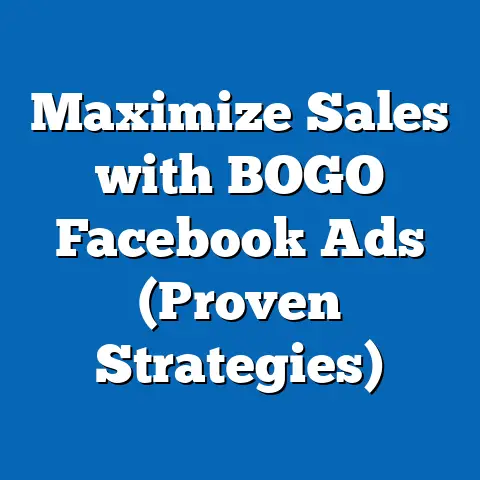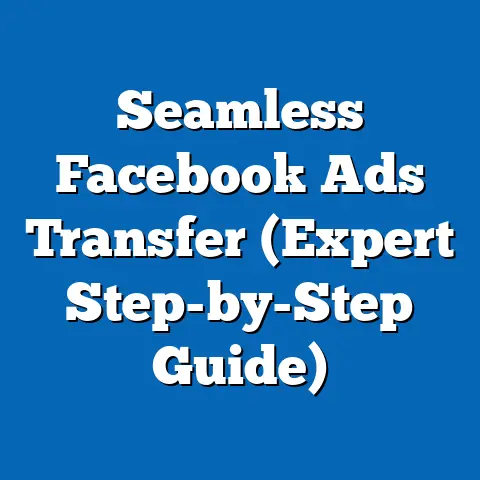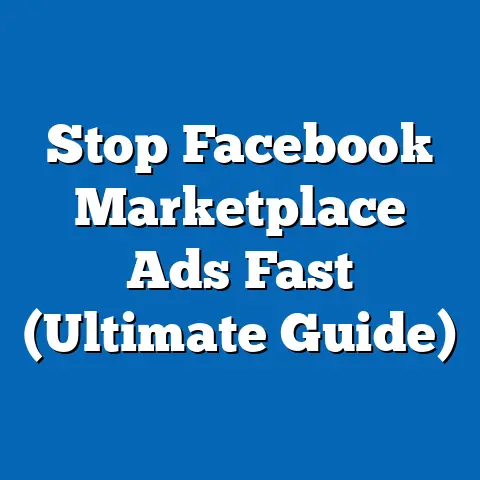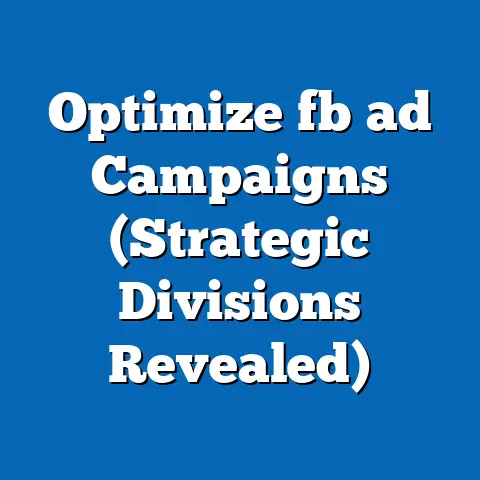Decode Facebook Ad Review Status (Expert Insights)
Have you ever felt the frustration of launching a Facebook ad campaign, only to have your ads stuck in a perpetual state of “In Review”? It’s a situation that’s all too common, and trust me, I’ve been there more times than I care to admit. The confusion surrounding Facebook’s ad review process can be incredibly disheartening. You pour your heart and soul into crafting the perfect ad, meticulously targeting your audience, and setting a budget, only to be met with silence or, worse, a dreaded “Disapproved” notification. This uncertainty not only delays your marketing efforts but can also throw your entire strategy off course, impacting your budget and overall business objectives. What happens when your carefully crafted ad gets lost in the review abyss, and how can you prevent this from happening?
Understanding Facebook’s Ad Review Process
Facebook’s ad review process is the gatekeeper of its advertising ecosystem. It’s designed to ensure that all ads comply with the platform’s strict advertising policies and community standards. This process aims to protect users from misleading, offensive, or harmful content, maintaining a positive user experience.
The review process isn’t just a formality; it’s a crucial step that determines whether your ad sees the light of day. Here’s a breakdown of the key stages:
-
Submission of the Ad: This is where it all begins. You create your ad in Ads Manager, defining your target audience, setting your budget, and crafting your ad creative.
-
Automated Review: Once submitted, your ad first goes through an automated review process. This involves algorithms that scan your ad copy, images, videos, and landing page for potential policy violations. The algorithms check for things like prohibited content, misleading claims, and inappropriate targeting.
-
Human Review: If the automated system flags your ad or if the algorithms are unsure, the ad is then reviewed by a human. Human reviewers assess the ad’s content, context, and targeting to ensure it aligns with Facebook’s policies.
-
Final Decision: After both automated and human reviews, a final decision is made. If your ad passes all checks, it’s approved and begins running. If it violates any policies, it’s disapproved, and you’ll receive a notification explaining why.
Submission of the Ad: This is where it all begins. You create your ad in Ads Manager, defining your target audience, setting your budget, and crafting your ad creative.
Automated Review: Once submitted, your ad first goes through an automated review process. This involves algorithms that scan your ad copy, images, videos, and landing page for potential policy violations. The algorithms check for things like prohibited content, misleading claims, and inappropriate targeting.
Human Review: If the automated system flags your ad or if the algorithms are unsure, the ad is then reviewed by a human. Human reviewers assess the ad’s content, context, and targeting to ensure it aligns with Facebook’s policies.
Final Decision: After both automated and human reviews, a final decision is made. If your ad passes all checks, it’s approved and begins running. If it violates any policies, it’s disapproved, and you’ll receive a notification explaining why.
I’ve learned that understanding this process is the first step in navigating it successfully. It’s not about tricking the system; it’s about aligning your ads with Facebook’s guidelines to create a positive experience for users while achieving your marketing goals.
Common Review Statuses Explained
Navigating the Facebook Ads Manager can sometimes feel like deciphering a secret code, especially when it comes to understanding the various ad review statuses. Each status provides a glimpse into where your ad stands in the approval process, and knowing what they mean can save you time and stress. Here’s a breakdown of the most common statuses:
-
In Review: This status indicates that your ad has been submitted and is currently being assessed by Facebook’s review system. The timeframe for this status can vary, usually taking anywhere from a few minutes to 24 hours, but sometimes it can stretch longer, especially during peak times or for ads that are more complex. It’s a waiting game, but patience is key.
-
Pending Review: This status is similar to “In Review,” but it often suggests that your ad is in a queue waiting for the review process to begin. Possible reasons for this status include high volumes of ad submissions or technical issues within Facebook’s system. It differs from “In Review” in that it precedes the actual assessment of your ad.
-
Approved: This is the status we all aim for! It means your ad has passed the review process and is now eligible to run. Once approved, your ad will start displaying to your target audience according to your campaign settings. It’s a green light to start reaching your marketing goals.
-
Disapproved: This is the status no one wants to see. It means your ad has violated one or more of Facebook’s advertising policies and cannot run. The reasons for disapproval can range from issues with ad copy and visuals to problems with targeting or landing page content. The good news is that you’ll receive a notification explaining why your ad was disapproved, giving you a chance to make the necessary corrections and resubmit it.
In Review: This status indicates that your ad has been submitted and is currently being assessed by Facebook’s review system. The timeframe for this status can vary, usually taking anywhere from a few minutes to 24 hours, but sometimes it can stretch longer, especially during peak times or for ads that are more complex. It’s a waiting game, but patience is key.
Pending Review: This status is similar to “In Review,” but it often suggests that your ad is in a queue waiting for the review process to begin. Possible reasons for this status include high volumes of ad submissions or technical issues within Facebook’s system. It differs from “In Review” in that it precedes the actual assessment of your ad.
Approved: This is the status we all aim for! It means your ad has passed the review process and is now eligible to run. Once approved, your ad will start displaying to your target audience according to your campaign settings. It’s a green light to start reaching your marketing goals.
Disapproved: This is the status no one wants to see. It means your ad has violated one or more of Facebook’s advertising policies and cannot run. The reasons for disapproval can range from issues with ad copy and visuals to problems with targeting or landing page content. The good news is that you’ll receive a notification explaining why your ad was disapproved, giving you a chance to make the necessary corrections and resubmit it.
To add some perspective, I spoke with Sarah Jones, a seasoned digital marketer who manages large-scale Facebook ad campaigns for e-commerce brands. “Understanding these statuses is crucial for campaign management,” she told me. “I’ve seen campaigns delayed by days because advertisers didn’t understand why their ads were stuck in ‘Pending Review’ or, worse, ‘Disapproved.’ Knowing what each status means allows you to take proactive steps to resolve issues quickly.”
The Impact of Review Status on Ad Performance
The review status of your ad isn’t just a technicality; it directly affects your ad’s performance and the overall success of your advertising campaign. Delays in approval can have significant implications on campaign timing, budget allocation, and overall marketing strategy.
Imagine you’re launching a time-sensitive campaign, like a flash sale or a seasonal promotion. If your ads get stuck in the review process for an extended period, you risk missing the critical window when your target audience is most receptive to your message. This can lead to wasted ad spend and missed opportunities.
According to a study by AdEspresso, ads that are disapproved and resubmitted often experience a decrease in performance compared to ads that are approved on the first try. This is because the initial momentum is lost, and the algorithm may penalize the ad for the previous violation.
Moreover, prolonged review times can disrupt your budget allocation. If your ads aren’t running, your budget isn’t being utilized effectively. This can throw off your entire marketing plan, especially if you’re working with a fixed budget.
To mitigate these risks, industry experts recommend optimizing your ad campaigns to align with Facebook’s policies from the outset. “Prevention is always better than cure,” says Mark Thompson, a Facebook ads consultant. “By understanding Facebook’s guidelines and adhering to them diligently, you can minimize the chances of your ads being delayed or disapproved. This not only saves time but also ensures that your campaigns run smoothly and efficiently.”
Expert Insights: Navigating the Review Process
Navigating Facebook’s ad review process can feel like walking a tightrope, but with the right strategies, you can significantly increase your chances of a smooth and successful journey. Here are some expert insights to help you submit ads that are more likely to be approved:
-
Ad Creative Best Practices:
- High-Quality Visuals: Use clear, high-resolution images and videos that accurately represent your product or service. Avoid misleading or deceptive visuals.
- Relevance: Ensure your ad creative is relevant to your target audience and the content of your landing page.
- Compliance with Guidelines: Familiarize yourself with Facebook’s advertising policies regarding prohibited content, such as hate speech, violence, and discrimination.
-
Ad Copy Compliance:
-
Accuracy: Make sure your ad copy is factually accurate and doesn’t make false or misleading claims.
- Clarity: Use clear, concise language that is easy to understand. Avoid jargon or technical terms that your target audience may not be familiar with.
- Respectful Tone: Maintain a respectful and professional tone in your ad copy. Avoid offensive or controversial language.
-
Targeting Guidelines:
-
Appropriate Targeting: Ensure your targeting options align with Facebook’s policies regarding sensitive categories, such as age, gender, and ethnicity.
- Relevance: Target your ads to audiences who are genuinely interested in your product or service. Avoid targeting based on assumptions or stereotypes.
Ad Creative Best Practices:
- High-Quality Visuals: Use clear, high-resolution images and videos that accurately represent your product or service. Avoid misleading or deceptive visuals.
- Relevance: Ensure your ad creative is relevant to your target audience and the content of your landing page.
- Compliance with Guidelines: Familiarize yourself with Facebook’s advertising policies regarding prohibited content, such as hate speech, violence, and discrimination.
-
Ad Copy Compliance:
-
Accuracy: Make sure your ad copy is factually accurate and doesn’t make false or misleading claims.
- Clarity: Use clear, concise language that is easy to understand. Avoid jargon or technical terms that your target audience may not be familiar with.
- Respectful Tone: Maintain a respectful and professional tone in your ad copy. Avoid offensive or controversial language.
-
Targeting Guidelines:
-
Appropriate Targeting: Ensure your targeting options align with Facebook’s policies regarding sensitive categories, such as age, gender, and ethnicity.
- Relevance: Target your ads to audiences who are genuinely interested in your product or service. Avoid targeting based on assumptions or stereotypes.
Ad Copy Compliance:
Accuracy: Make sure your ad copy is factually accurate and doesn’t make false or misleading claims.
Targeting Guidelines:
Appropriate Targeting: Ensure your targeting options align with Facebook’s policies regarding sensitive categories, such as age, gender, and ethnicity.
I once worked on a campaign for a health supplement company where our ads were repeatedly disapproved due to claims that violated Facebook’s policies. After consulting with a compliance expert, we revised our ad copy to focus on the benefits of the product rather than making specific health claims. This simple change resulted in our ads being approved and significantly improved our campaign performance.
Conclusion
The ad review process on Facebook can feel like a labyrinth, but understanding its intricacies is key to running successful campaigns. It’s not just about avoiding disapproval; it’s about aligning your advertising strategies with Facebook’s community standards.
By understanding the review process, the various ad statuses, and the impact of delays, you can take proactive steps to optimize your ads for approval. Remember, the review process isn’t just a hurdle; it’s an opportunity to refine your advertising strategies and align more closely with Facebook’s community standards.
As you navigate the ever-evolving landscape of digital advertising, keep in mind that understanding platform-specific processes is essential for achieving success. By embracing this mindset, you’ll not only improve your chances of getting your ads approved but also create more effective and impactful campaigns that resonate with your target audience.






